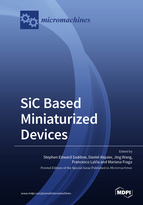SiC based Miniaturized Devices
A special issue of Micromachines (ISSN 2072-666X). This special issue belongs to the section "D:Materials and Processing".
Deadline for manuscript submissions: closed (31 December 2019) | Viewed by 44958
Special Issue Editors
Interests: SiC; neural interfaces; SiC MEMS; biotechnology
Special Issues, Collections and Topics in MDPI journals
Interests: wide band gap (SiC & GaN); Power devices; MEMS; NEMS; material processing; doping
Interests: advanced manufacturing; MEMS/NEMS transducers; nanomaterials and nanotechnology; microfluidics and biosensors; RF/microwave electronics
Special Issues, Collections and Topics in MDPI journals
Interests: silicon carbide; growth; defects; MEMS; detectors
Special Issues, Collections and Topics in MDPI journals
Interests: materials science; energy; microelectronics; aerospace engineering; biomedical engineering and bioengineering
Special Issues, Collections and Topics in MDPI journals
Special Issue Information
Dear Colleagues,
MEMS devices are found in many of today’s electronic devices and systems, from air-bag sensors in cars to smart phones, embedded systems, etc. Increasingly, the reduction in dimensions has led to nanometer-scale devices, called NEMS. The plethora of applications on the commercial market speaks for itself, and especially for the highly precise manufacturing of silicon-based MEMS and NEMS. While this is a tremendous achievement, silicon as a material has some drawbacks, mainly in the area of mechanical fatigue and thermal properties. Silicon carbide (SiC), a well-known wide-bandgap semiconductor whose adoption in commercial products is experiening exponential growth, especially in the power electronics arena. While SiC MEMS have been around for decades, in this Special Issue we seek to capture both an overview of the devices that have been demonstrated to date, as well as bring new technologies and progress in the MEMS processing area to the forefront. Thus, this Special Issue seeks to showcase research papers, short communications, and review articles that focus on: (1) novel designs, fabrication, control, and modeling of SiC MEMS and NEMS based on all kinds of actuation mechanisms; and (2) new developments in applying SiC MEMS and NEMS in consumer electronics, optical communications, industry, medicine, agriculture, space, and defense.
Prof. Dr. Stephen Edward Saddow
Prof. Dr. Daniel Alquier
Prof. Dr. Jing Wang
Dr. Francesco La Via
Dr. Mariana Fraga
Guest Editors
Manuscript Submission Information
Manuscripts should be submitted online at www.mdpi.com by registering and logging in to this website. Once you are registered, click here to go to the submission form. Manuscripts can be submitted until the deadline. All submissions that pass pre-check are peer-reviewed. Accepted papers will be published continuously in the journal (as soon as accepted) and will be listed together on the special issue website. Research articles, review articles as well as short communications are invited. For planned papers, a title and short abstract (about 100 words) can be sent to the Editorial Office for announcement on this website.
Submitted manuscripts should not have been published previously, nor be under consideration for publication elsewhere (except conference proceedings papers). All manuscripts are thoroughly refereed through a single-blind peer-review process. A guide for authors and other relevant information for submission of manuscripts is available on the Instructions for Authors page. Micromachines is an international peer-reviewed open access monthly journal published by MDPI.
Please visit the Instructions for Authors page before submitting a manuscript. The Article Processing Charge (APC) for publication in this open access journal is 2600 CHF (Swiss Francs). Submitted papers should be well formatted and use good English. Authors may use MDPI's English editing service prior to publication or during author revisions.
Keywords
- SiC microsystems
- SiC MEMS
- SiC biomedical devices
- SiC micromachines
- SiC microsensors
Related Special Issue
- SiC Based Miniaturized Devices, Volume II in Micromachines (3 articles)










